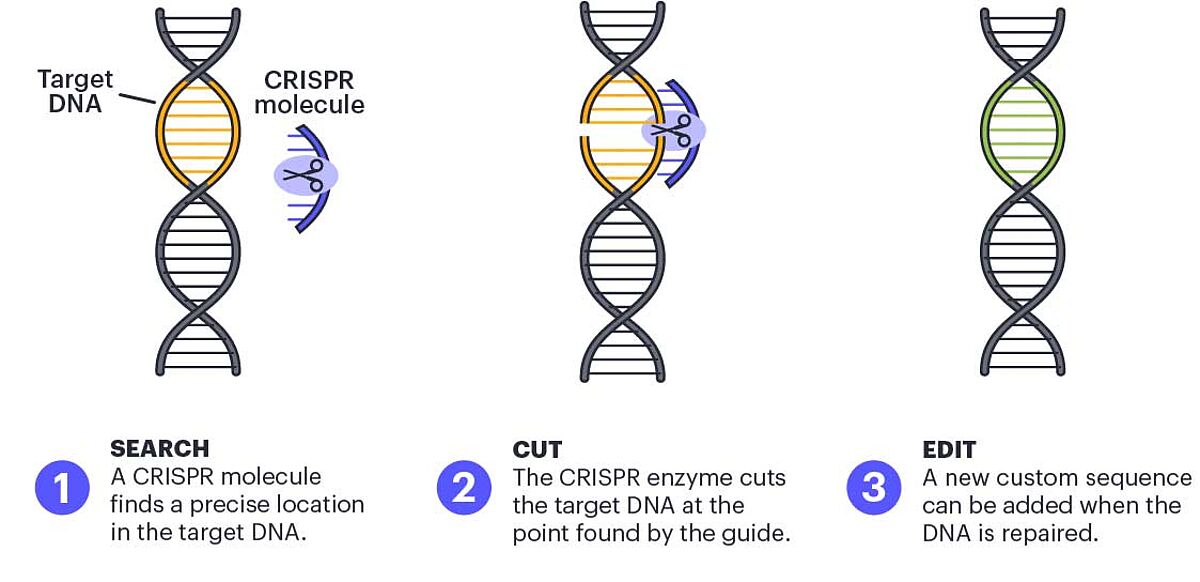CRISPR Gene Editing: A Powerful System For Whole Gene Insertion

Table of Contents
Understanding CRISPR-Cas Systems and Whole Gene Insertion
CRISPR-Cas9, a type of CRISPR system, is a revolutionary gene-editing tool derived from a bacterial defense mechanism. It works by using a guide RNA (gRNA) molecule to target a specific DNA sequence. The Cas9 enzyme then acts like molecular scissors, cutting the DNA at the targeted location. This allows scientists to precisely edit the genome, including inserting new genes.
The difference between gene editing and whole gene insertion lies in the scale of the modification. Gene editing often involves making small changes, like knocking out a gene (knocking out its function) or knocking in a modified version of a gene. Whole gene insertion, however, involves the introduction of a complete, functional gene into the genome. This is significantly more challenging.
Traditional methods for inserting large gene sequences, such as viral vectors, often suffer from limitations in efficiency, precision, and the size of the DNA they can carry. They can also lead to insertional mutagenesis, where the new gene disrupts the function of other genes. CRISPR overcomes these challenges through its remarkable precision and efficiency.
CRISPR's advantages in whole gene insertion stem from:
- Target specificity through guide RNA design: The gRNA acts as a GPS, ensuring that the Cas9 enzyme cuts the DNA at the precisely intended location.
- Homology-directed repair (HDR) pathway for precise insertion: After the DNA is cut, the cell's natural repair mechanisms are harnessed. A donor DNA template containing the desired gene is provided, and the cell uses this template to accurately insert the new gene into the cut site.
- Use of donor DNA templates for gene insertion: This allows for the precise insertion of genes of any size, overcoming the limitations of traditional methods.
- Advantages over traditional methods (e.g., viral vectors): CRISPR offers higher precision, efficiency, and the ability to insert larger genes compared to viral vectors, which have size limitations and can lead to off-target integrations.
Applications of CRISPR for Whole Gene Insertion
CRISPR's ability to precisely insert whole genes has opened up unprecedented opportunities across various fields.
Therapeutic Applications
Whole gene insertion using CRISPR holds immense promise for treating a wide range of genetic disorders:
-
Gene therapy for monogenic disorders: Conditions like cystic fibrosis and sickle cell anemia are caused by single gene mutations. Whole gene insertion offers the potential to correct these faulty genes by inserting functional copies.
-
Cancer immunotherapy: Inserting genes that enhance the activity of immune cells (e.g., CAR T-cell therapy) can improve the body's ability to fight cancer.
-
Treating inherited metabolic disorders: Many metabolic disorders result from deficiencies in specific enzymes. Whole gene insertion can replace these deficient genes, potentially alleviating symptoms.
-
Examples of successful clinical trials or pre-clinical studies: Several clinical trials are underway exploring the use of CRISPR for various therapeutic applications. While still in early stages, the results are promising.
-
Discussion of potential challenges and limitations in therapeutic applications: Challenges include efficient delivery of the CRISPR-Cas system to target cells, minimizing off-target effects, and addressing potential immune responses.
Agricultural Applications
CRISPR is revolutionizing agriculture by enabling the precise insertion of genes to improve crop yields and nutritional value:
-
Improving crop yields and nutritional value: Inserting genes for pest resistance, drought tolerance, and enhanced nutrient content can lead to more productive and resilient crops.
-
Developing disease-resistant livestock: CRISPR can be used to insert genes conferring resistance to various diseases, reducing the need for antibiotics and improving animal health.
-
Examples of successful applications in agriculture: Several genetically modified crops with improved traits have been developed using CRISPR technology.
-
Ethical considerations regarding genetically modified organisms (GMOs): The use of CRISPR in agriculture raises ethical concerns that need careful consideration, including the potential impact on biodiversity and the labeling of GMOs.
Research Applications
CRISPR's precision makes it an invaluable tool for fundamental research:
-
Creating disease models for studying human diseases: Precise insertion of disease-causing mutations in model organisms allows for the study of disease mechanisms and the testing of new therapies.
-
Functional genomics: Studying gene function through precise gene insertion and subsequent analysis of the effects on cellular processes.
-
Examples of research applications using CRISPR for whole gene insertion: CRISPR is widely used in research labs worldwide to study gene function, model human diseases, and develop new gene therapies.
-
Discussion of the contribution of CRISPR to scientific advancement: CRISPR has significantly accelerated research progress in diverse fields by facilitating precise and efficient genome engineering.
Challenges and Ethical Considerations
Despite its immense potential, CRISPR technology faces several challenges and ethical considerations:
-
Off-target effects: The possibility of unintended edits at locations other than the target site remains a concern.
-
Delivery methods: Efficient and safe delivery of CRISPR-Cas systems to target cells or organisms remains a major challenge.
-
Ethical implications: The use of CRISPR raises profound ethical concerns, particularly regarding germline editing (making changes that can be passed on to future generations), equitable access to this technology, and the potential for misuse.
-
Strategies to minimize off-target effects: Researchers are actively developing strategies to minimize off-target effects, such as using improved gRNA design, paired nickases, and enhanced Cas enzymes.
-
Advances in delivery methods: Advances in viral and non-viral delivery systems are being made to improve the efficiency and safety of CRISPR delivery.
-
Importance of ethical guidelines and regulations for CRISPR applications: Strict ethical guidelines and regulations are crucial to ensure responsible development and application of this powerful technology.
Conclusion
CRISPR gene editing, specifically its capacity for whole gene insertion, represents a monumental advancement in genetic engineering. Its precision, efficiency, and broad applications across therapeutic, agricultural, and research domains hold immense promise. While challenges remain, particularly regarding off-target effects and ethical considerations, ongoing research and development are continuously refining this technology, paving the way for a future where gene-based diseases are effectively treated and complex biological systems are better understood. Further research and responsible development of CRISPR-based whole gene insertion technologies are crucial to fully realizing its potential and ensuring its ethical application. Learn more about the possibilities of CRISPR gene editing and its future advancements in whole gene insertion by exploring the latest scientific literature.

Featured Posts
-
 Those British Faces Exploring The Legacy Of Anna Neagle
May 30, 2025
Those British Faces Exploring The Legacy Of Anna Neagle
May 30, 2025 -
 Alcaraz Triumphs In Monte Carlo Overcoming Adversity For Masters Glory
May 30, 2025
Alcaraz Triumphs In Monte Carlo Overcoming Adversity For Masters Glory
May 30, 2025 -
 Noticias De Ticketmaster Incidente Del 8 De Abril Y Soluciones
May 30, 2025
Noticias De Ticketmaster Incidente Del 8 De Abril Y Soluciones
May 30, 2025 -
 Programma Tileoptikon Metadoseon Kyriakis 11 5
May 30, 2025
Programma Tileoptikon Metadoseon Kyriakis 11 5
May 30, 2025 -
 Two Women Rescued In Otay Mountains By Border Patrol Agents
May 30, 2025
Two Women Rescued In Otay Mountains By Border Patrol Agents
May 30, 2025
Latest Posts
-
 Grigor Dimitrov Vliyanieto Na Kontuziyata Vrkhu Karierata Mu
May 31, 2025
Grigor Dimitrov Vliyanieto Na Kontuziyata Vrkhu Karierata Mu
May 31, 2025 -
 Kontuziyata Na Grigor Dimitrov Aktualna Informatsiya I Analiz
May 31, 2025
Kontuziyata Na Grigor Dimitrov Aktualna Informatsiya I Analiz
May 31, 2025 -
 Trumps Uncertainty What Made Him Question Elon Musk
May 31, 2025
Trumps Uncertainty What Made Him Question Elon Musk
May 31, 2025 -
 Uncertainty And The End Trumps Doubts About Elon Before The Break
May 31, 2025
Uncertainty And The End Trumps Doubts About Elon Before The Break
May 31, 2025 -
 Everything Revealed In The Star Trek Strange New Worlds Season 3 Teaser
May 31, 2025
Everything Revealed In The Star Trek Strange New Worlds Season 3 Teaser
May 31, 2025
